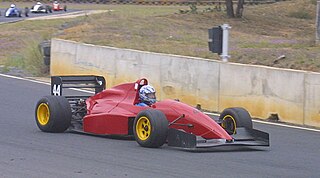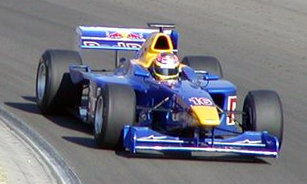
The Formula 3000 International Championship was a motor racing series created by the Fédération Internationale de l'Automobile (FIA) in 1985 to become the final preparatory step for drivers hoping to enter Formula One. Formula Two had become too expensive, and was dominated by works-run cars with factory engines; the hope was that Formula 3000 would offer quicker, cheaper, more open racing. The series began as an open specification, then tyres were standardized from 1986 onwards, followed by engines and chassis in 1996. The series ran annually until 2004, and was replaced in 2005 by the GP2 Series.
Lola Cars International Ltd. was a British race car engineering company in operation from 1958 to 2012. The company was founded by Eric Broadley in Bromley, England, before moving to new premises in Slough, Buckinghamshire and finally Huntingdon, Cambridgeshire, and endured for more than fifty years to become one of the oldest and largest manufacturers of racing cars in the world. Lola Cars started by building small front-engined sports cars, and branched out into Formula Junior cars before diversifying into a wider range of sporting vehicles.
Pacific Racing was a motor racing team from the United Kingdom. Following success in lower formulae, the team took part in two full seasons of Formula One, in 1994 and 1995, entering 33 Grands Prix without any success.
Giovanna Amati is an Italian former professional racing driver. She is the most recent female driver to have entered the Formula One World Championship.

Formula Holden was an Australian open wheel racing category introduced in 1989.
The 1991 Formula 3000 International Championship was the seventh season of Formula 3000 in Europe. Christian Fittipaldi won the championship after ten rounds.
The 1992 Formula 3000 International Championship was the eighth season of Formula 3000 in Europe. Luca Badoer won the ten-round championship.
The 1993 FIA Formula 3000 International Championship was a motor racing series for Formula 3000 cars. Contested over nine races, it was the ninth FIA Formula 3000 International Championship.
The 1994 Formula 3000 International Championship was the tenth season of Formula 3000 in Europe. Jean-Christophe Boullion won the championship after eight rounds.
Gary Anderson is a British semi-retired racing car designer and motorsport pundit/commentator.
The British Formula 3000 championship, alternatively known as the British Formula Two Championship, was a competition for Formula 3000 held in the United Kingdom, active from 1989 to 1994 and in 1996. Several attempts to restart the series since then have met with failure.

Formula 3000 (F3000) was a type of open wheel, single seater formula racing, occupying the tier immediately below Formula One and above Formula Three. It was so named because the cars were powered by 3.0 L engines.
The 2000 Australian Drivers' Championship was a CAMS sanctioned national motor racing title for drivers of cars conforming to Formula Holden regulations. The title was contested over an 8-round, 16 race series with the winner awarded the 2000 CAMS Gold Star. The championship, which was promoted as the 2000 Holden Australian Drivers' Championship, was the 44th Australian Drivers' Championship and the 12th to be contested with Formula Holden or Formula Brabham cars.
The 1998 Australian Drivers' Championship was a CAMS sanctioned Australian motor racing title for drivers of cars conforming to Formula Holden regulations. The title was contested over a six-round, twelve race series with the winner awarded the CAMS Gold Star. Officially the "Holden Australian Drivers' Championship for the CAMS Gold Star", it was the 42nd Australian Drivers' Championship.

Reynard Motorsport was the world's largest racing car manufacturer in the 1980s. Initially based at Bicester and latterly at Reynard Park, Brackley, England the company built successful cars in Formula Ford 1600, Formula Ford 2000, Formula Vauxhall Lotus, Formula Three, Formula 3000 and CART.
Roy Peter Lovenkjaer Olsson is a former professional racing driver, now a chiropractor, resident in England. Olsson competed in the British Formula Two Championship in 1992, finishing sixth overall in the Drivers' Championship. He also raced several times in the British Formula 3000 Championship in 1991 and the International Formula 3000 Championship in 1994 and 1996.
Paulo Carcasci is a former Brazilian racing driver. Carcasci won the 1985 European FF 1600 Championship , 1988 BBC FF2000 Championship, 1991 All-Japan Formula Three Championship and the Gold Cup in Formula 3000.
The Reynard 95D is an open-wheel formula race car, designed and developed by Malcolm Oastler, and constructed and built by Reynard Motorsport, for use in Formula 3000 categories, Formula Nippon, and Formula Holden racing series', in 1995.
The Reynard 90D is a Formula 3000 car, designed and developed by Malcolm Oastler, and constructed and built by Reynard Motorsport, in 1990.
The 1994 British Formula Two Championship was the sixth season of the British Formula 3000 Championship. José Luis Di Palma won the championship, driving a Reynard 92D for Madgwick International. Both the Argentinian and series runner-up Phil Andrews won two rounds apiece. However, the grids were weak and British F2 was in decline. International F3000 drivers Gareth Rees and Christian Pescatori both won one-off races with Durango, at Snetterton and Donington respectively. Future Indy Lights star Philipp Peter also had a single race with the Italian team. Rees' future team-mate Stephen Watson made a single appearance in the series. The Moosehead Grand Prix at Halifax, Canada, a non-championship F3000 race in 1993, counted as a British F2 round in 1994 and was won by the Italian-Mexican Gianfranco Cané, driving for Fred Goddard Racing.




